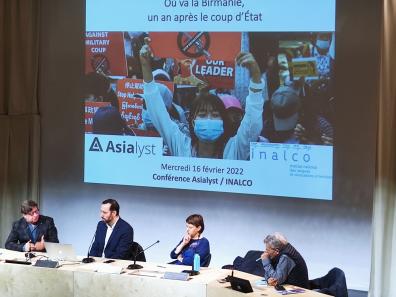Keynote speaker: Bruno Philip, journalist and Le Monde correspondent in Southeast Asia

How the coup came about
On February 1, 2021 Burma's civilian government was overthrown by the army, commanded by General Min Aung Hlaing. State Councillor Aung San Suu Kyi, a member of the National League for Democracy (NLD), elected on November 8, 2020, is arrested and placed under house arrest by military forces, who at the same time declare the state of emergency.
Bruno Philip, journalist and Bangkok correspondent for Le Monde, points out that Burma has already been ruled by a military regime that began in 1962. This period of unrest and successive coup attempts was also marked by the pro-democracy movement in 1988 which was "washed in blood by the Burmese army". However by 2010, the army withdrew from power and a process of democratization began. In 2020 democratic elections are held, the government is then composed of a civilian government and a military government that occupies several ministries such as defense, borders and the interior. Despite the NDA's compromises with the army, their relations quickly deteriorate until they find themselves "almost overnight" back under military rule.
Consequences of the military coup
In the weeks that follow, a "large-scale uprising" against the army begins and several thousand Burmese take to the streets to condemn the pustch, leading to a violent repression by the military junta leaving over 1,500 dead and leading to more than 1,200 arrests in one year. However, "day-to-day resistance" continues to endure in the cities, including calls for silent strikes, one year to the day after the coup. On the borders and throughout the country, ethnic guerrillas continue to battle General Min Aung Hlaing's army.
The balance sheet for this year is therefore "catastrophic" in the words of the reporter:
- Economically, almost half of Burmese now live below the poverty line
- The national currency has collapsed
- Exports and imports are almost non-existent
- The country's growth has fallen by almost 18% in one year.

Resistance and ethnic minorities
This "total rejection of the army" and extremely strong resistance had already been expressed through the elections leading to the NLD's victory in 2020, according to Alexandra de Mersan, teacher-researcher at Inalco and anthropologist specializing in Burma, migration and religion. She also points out that Burma is made up of seven official states, and is often referred to as an "ethnic mosaic", illustrating the complexity of the Burmese situation but above all its great diversity. There are officially 135 ethnic groups, geographically distributed in border areas, with the center of the country predominantly occupied by Burmese populations.

The question of national unity in Burma has therefore been a major issue for successive governments since the country's independence in 1948. This resistance is a continuation of the desire for unity and democratization that has been underway for the past ten years, but which was unfortunately completely undermined by the overthrow of the democratic government in February 2021. These groups are also seeking recognition for their diversity, notably through armed movements, which have sprung up in all sections of Burmese society against the military junta, as illustrated by the alliances between the various "people's defense committees" (People's defense force) and ethnic armies.
Withdrawal of TotalEnergies
This political and humanitarian crisis plunges Burma into an economic crisis that isolates it from the international community, and is amplified by the withdrawal of investors established in the country. Francis Christophe, independent journalist and Burma specialist, highlights the seriousness of the departure of French company TotalEnergies, present in the territory since 1992,and its American partner Unocal-Chevron on January 21 for the local economy, but also for the ruling military regime.
Find the full Grand Témoin lecture-debate"Where is Burma going, one year after the coup?" in replay
Edited by: Cécile Leblond / Inalco Foundation